Are you curious about how to eat Bún Chả like a local in Hanoi? Bún Chả, a culinary jewel of Vietnamese cuisine, is more than just a meal; it’s an experience. At SIXT.VN, we help you explore Vietnam through its authentic flavors, starting with this iconic dish. Discover the traditional method of enjoying Bún Chả, which involves dipping vermicelli noodles in a flavorful sauce, and prepare to immerse yourself in a delightful gastronomic adventure. Let’s delve into the art of savoring Bún Chả and uncover why it’s a must-try for any visitor to Vietnam.
1. What Exactly is Bún Chả? A Culinary Introduction
Bún Chả is a quintessential Northern Vietnamese dish, especially popular in Hanoi, celebrated for its harmonious blend of tastes and textures. This delightful dish comprises grilled pork patties (chả), sometimes accompanied by thinly sliced pork belly and shrimp, served with soft rice vermicelli noodles (bún), a medley of fresh herbs, and a distinctive sweet and savory dipping broth made from fish sauce. The beauty of Bún Chả lies in its balance of the five fundamental flavors: sweet, sour, salty, spicy, and smoky.
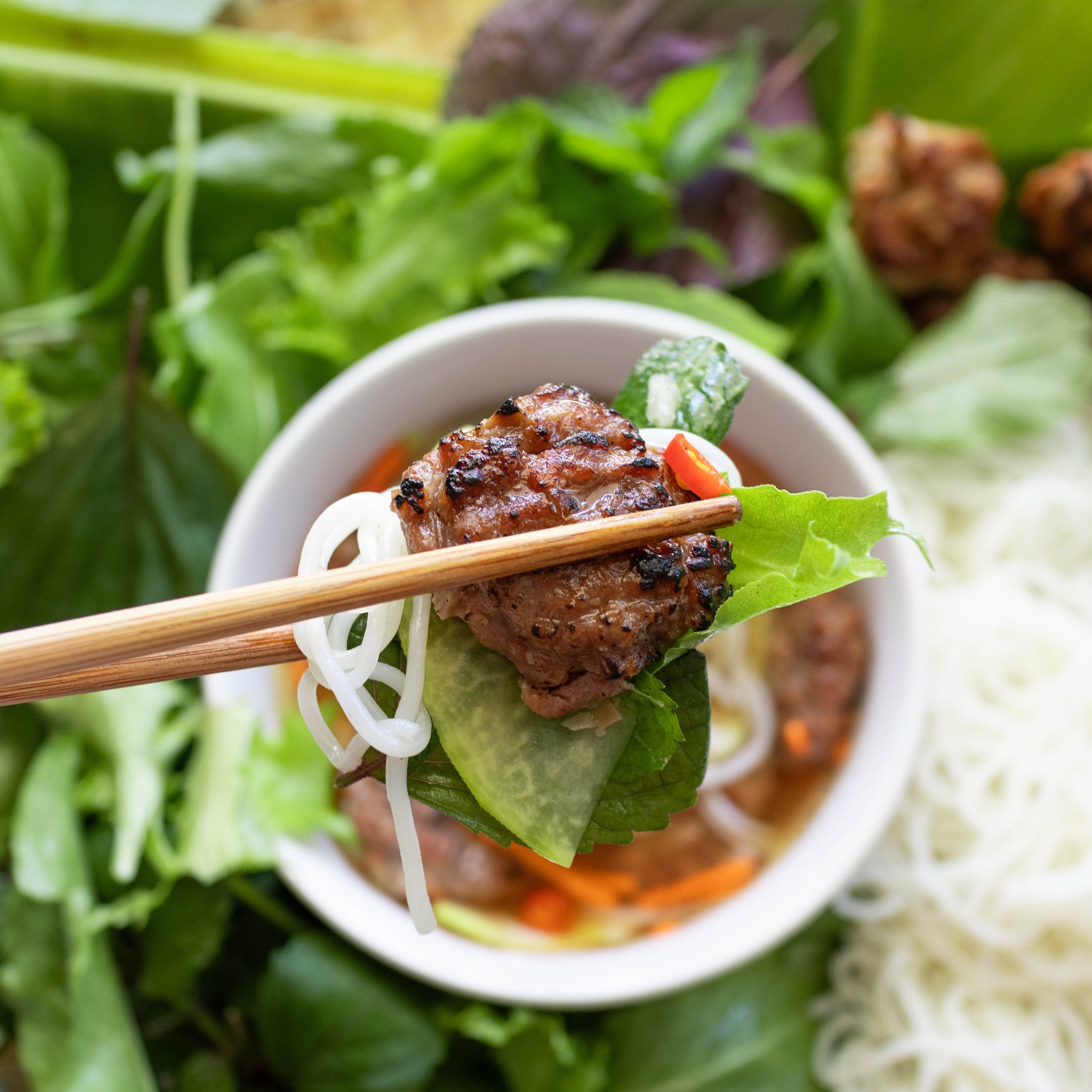 Bún Chả Hanoi: Grilled Pork with Vermicelli Noodles
Bún Chả Hanoi: Grilled Pork with Vermicelli Noodles
2. How is Bún Chả Typically Served in Hanoi?
Bún Chả is traditionally served in a deconstructed manner, enhancing the dining experience. Typically, the rice noodles and a variety of fresh herbs are presented on a separate plate, while the grilled pork patties are served in a bowl filled with the flavorful dipping sauce. Pickled vegetables, such as daikon, carrots, or papaya, are often included either directly in the dipping sauce or served on the side. The dipping sauce, light and aromatic, is integral to the dish and can even be enjoyed as a broth.
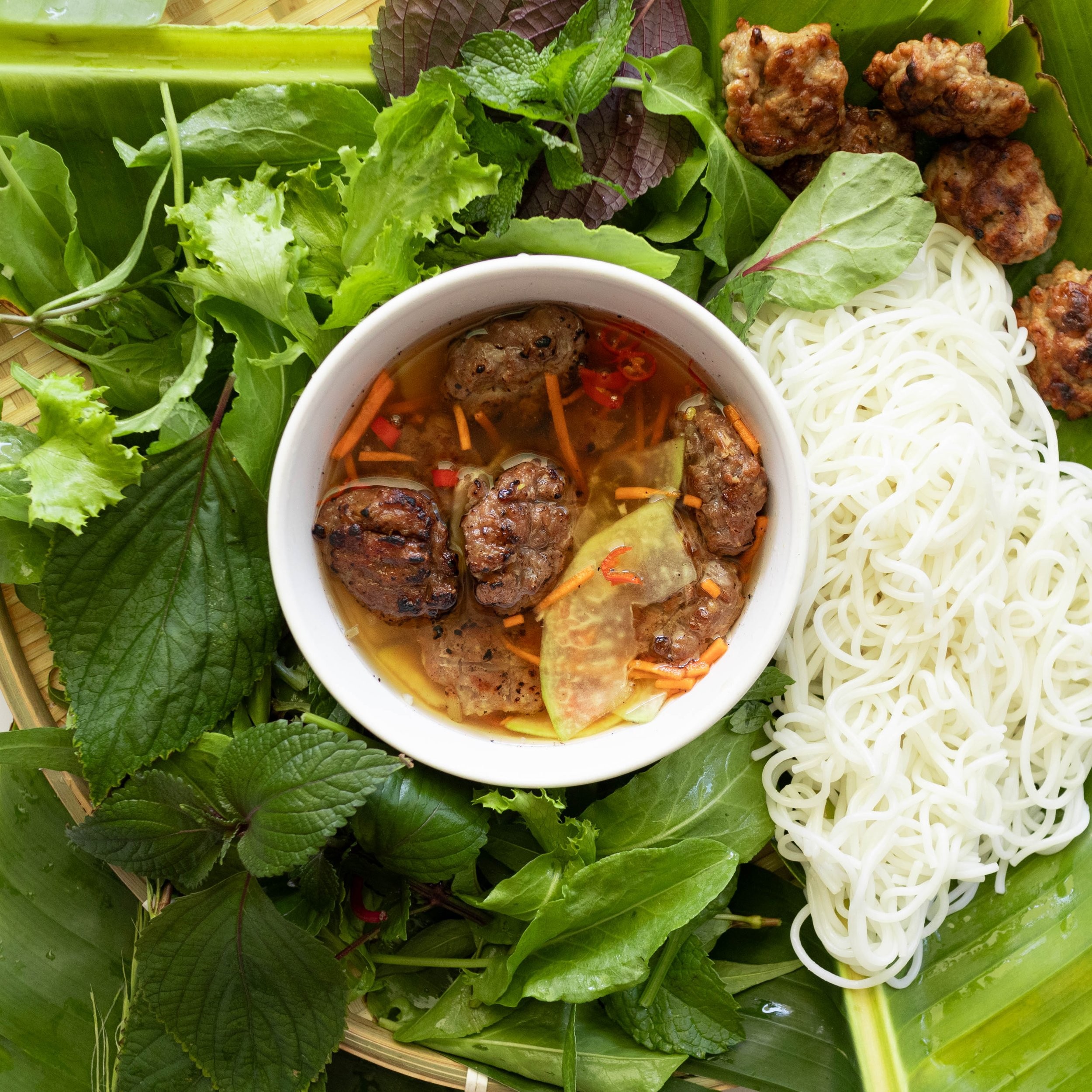 Serving Bún Chả: Noodles, Herbs, and Grilled Pork
Serving Bún Chả: Noodles, Herbs, and Grilled Pork
3. What is the Traditional Way to Eat Bún Chả? The Art of Dipping
The authentic way to eat Bún Chả in Hanoi involves using the bowl containing the meat and broth as your main eating vessel. Follow these steps for an immersive culinary experience:
- Add Noodles: Place a portion of the rice vermicelli noodles into the bowl with the grilled pork and dipping sauce.
- Incorporate Herbs: Tear your favorite fresh vegetables and herbs into smaller, bite-sized pieces and add them to the bowl. Common herbs include basil, mint, and cilantro, each adding a unique layer of flavor.
- Mix and Swirl: Gently mix everything together in the dipping sauce, allowing the noodles and herbs to absorb the flavors of the broth.
- Enjoy Each Bite: Savor each bite by pairing the noodles and herbs with a grilled pork patty and some pickled vegetables. The combination of textures and flavors is what makes Bún Chả so unique.
- Repeat: Continue this process for each bite, ensuring a balanced mix of noodles, herbs, pork, and pickled vegetables.
 How to Eat Bún Chả: Mixing Noodles and Herbs
How to Eat Bún Chả: Mixing Noodles and Herbs
4. Bún Chả vs. Bún Thịt Nướng: Understanding the Differences
While Bún Chả is a Northern Vietnamese specialty, Bún Thịt Nướng is its Southern counterpart. Both dishes feature grilled pork, fresh herbs, and a sweet chili dipping sauce, but there are several key distinctions:
| Feature | Bún Chả (Northern) | Bún Thịt Nướng (Southern) |
|---|---|---|
| Serving Style | Served deconstructed, with noodles and grilled pork patties served separately. Diners construct each bite by dipping noodles, vegetables, and herbs into the sauce with pork patties. | Served more traditionally, with all ingredients together in a bowl, except for the sauce. Diners drizzle the sauce over the noodles and toss everything together. |
| Dipping Sauce | Typically sweeter and lighter, often referred to as broth due to its lightness and the way the pork patties are served in it. | Generally richer and more robust, with a stronger presence of fish sauce and chili. |
| Pickled Vegetables | Traditionally uses pickled papaya, offering a slightly sweet and tangy flavor. | Commonly uses pickled daikon and carrot, providing a crisp and slightly sour element. |
| Pork | Typically features ground pork formed into patties (chả), offering a tender and slightly smoky flavor. | Uses thinly sliced pork shoulder or butt (thịt nướng), marinated and grilled to perfection, providing a slightly caramelized and savory taste. |
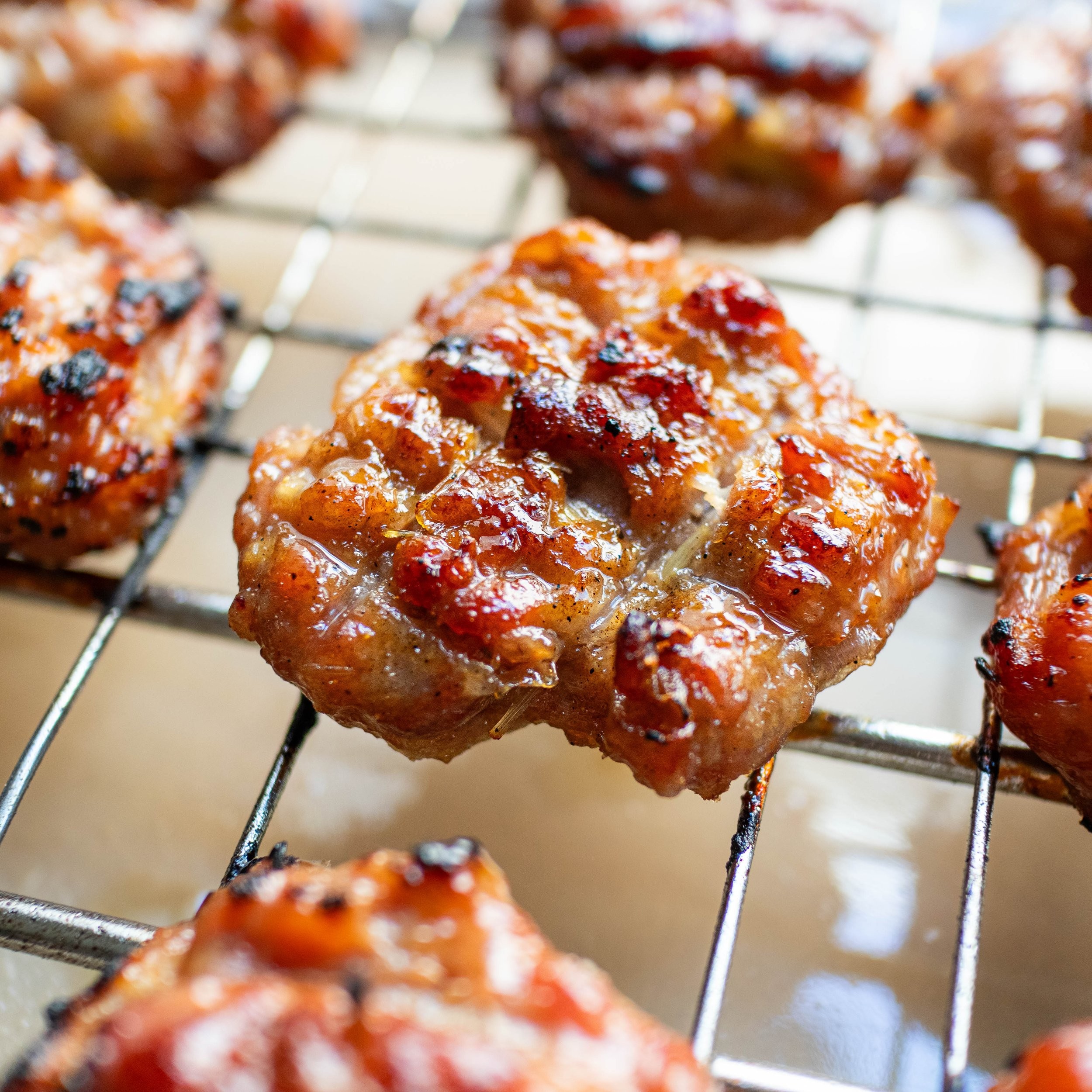 Cooked Pork Patties for Bún Chả
Cooked Pork Patties for Bún Chả
5. What are the Essential Ingredients for Making Bún Chả?
To prepare authentic Bún Chả, you will need the following key ingredients:
- Fatty Ground Pork: Essential for making the flavorful pork patties. Aim for at least 20% fat content to ensure the patties remain moist and delicious during grilling.
- Fish Sauce and Oyster Sauce: These are the primary seasoning ingredients, providing a salty and umami-rich base for the pork marinade.
- Brown Sugar: Adds sweetness and helps to caramelize the pork patties during grilling, creating a delicious glaze.
- Ground Black Pepper: Provides a hint of peppery flavor, enhancing the overall taste profile.
- Roasted Rice Powder: Adds a toasty flavor and helps to bind the pork patties together, ensuring they hold their shape during grilling.
- MSG (Optional): Enhances the overall flavor, but can be omitted based on personal preference.
- Lemongrass, Garlic, and Shallots: These aromatics infuse the pork with a distinctive Southeast Asian fragrance and flavor.
- Neutral Oil: Used to lightly oil your hands, preventing the pork mixture from sticking while forming the patties.
- Dipping Sauce/Broth: A mild, sweet, and savory sauce made from water, lemon juice, chili peppers, and coconut juice or soda.
- Fresh Vegetables: A variety of fresh vegetables and herbs, such as lettuce, cucumber, and Vietnamese herbs, to add freshness and complexity to the dish.
- Pickled Vegetables: Pickled papaya, kohlrabi, or green unripe mango are traditionally used to add a refreshing crunch. Pickled daikon and carrot are also excellent alternatives.
- Round Rice Noodles: Medium-sized round rice noodles are the standard choice for Bún Chả. Ensure they are not too thick or too thin for the best texture.
 Seasonings for Marinating Pork for Bún Chả
Seasonings for Marinating Pork for Bún Chả
6. Step-by-Step Guide to Making Bún Chả at Home
Follow these steps to recreate the authentic taste of Bún Chả in your own kitchen:
Step 1: Season the Pork
In a large mixing bowl, combine the ground pork, fish sauce, oyster sauce, brown sugar, ground black pepper, roasted rice powder, MSG (if using), minced lemongrass, garlic, and shallots. Mix thoroughly to ensure all ingredients are well combined.
Step 2: Form Patties and Grill
Lightly oil your hands with vegetable oil to prevent the pork mixture from sticking. Roll the mixture into approximately 32 small patties. Grill the patties over a charcoal fire for an authentic smoky flavor, about 8 minutes per side, or until lightly charred. Alternatively, you can pan-fry the patties on high heat on the stovetop or air-fry them at 350°F for about 5 minutes per side.
Using a metal wire grilling basket can be helpful for smaller patties, preventing them from falling through the grill grates and ensuring even cooking.
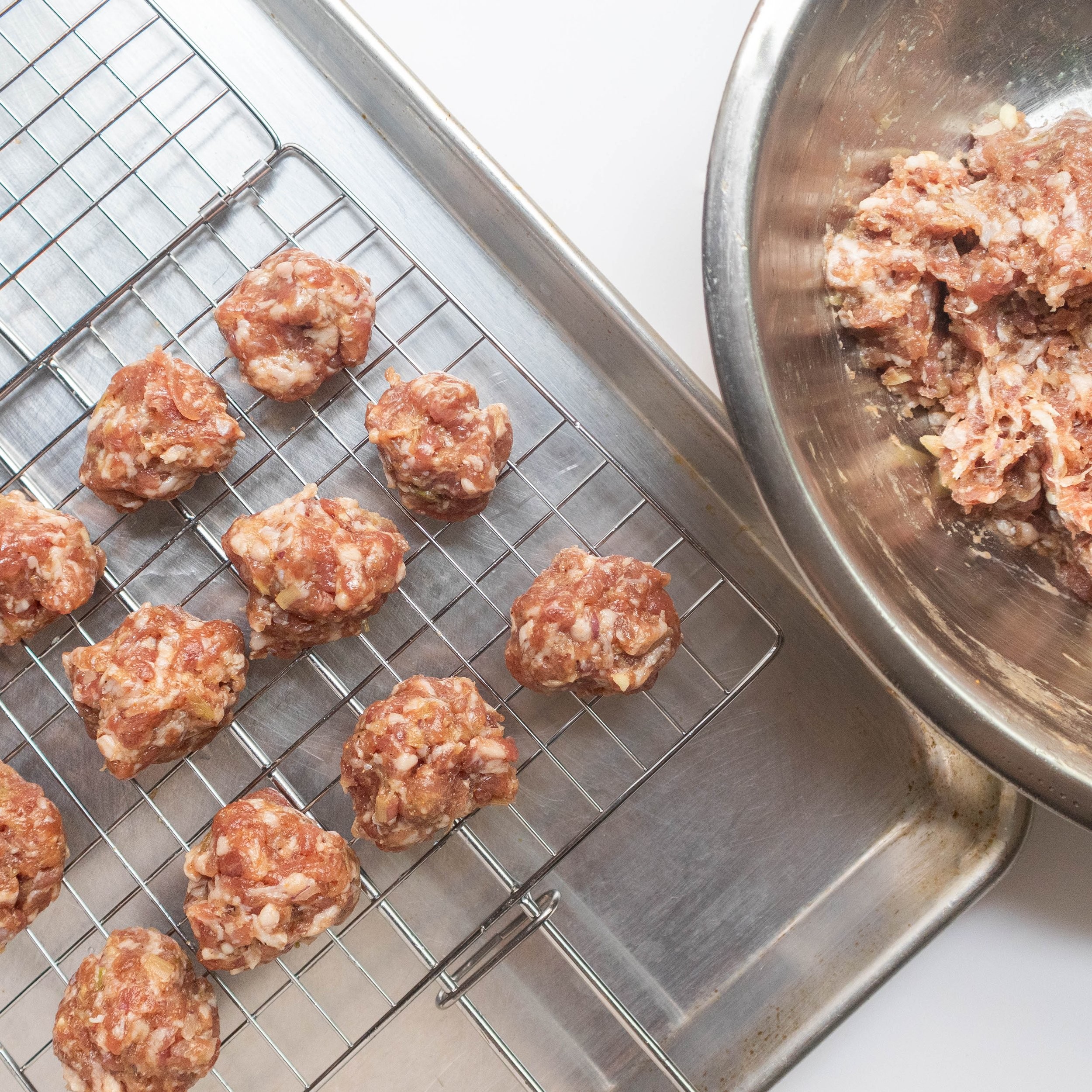 Assembling Pork Meatballs for Grilling
Assembling Pork Meatballs for Grilling
 Metal Wire Basket with Pork Patties Ready for Grilling
Metal Wire Basket with Pork Patties Ready for Grilling
Step 3: Prepare Quick Pickled Papaya
In a medium bowl, combine thinly sliced papaya with salt and let it sit for 30 minutes. Rinse the salted papaya under cold running water and squeeze out any excess water. Drain well and mix with water, sugar, and vinegar. Set aside.
Step 4: Make the Dipping Sauce/Broth
In a large bowl, mix together hot water and sugar until the sugar is completely dissolved. Add fish sauce, lime juice, coconut soda, minced garlic, and thinly sliced chili peppers. Adjust the amounts to taste, ensuring a balanced sweet, sour, and savory flavor.
Step 5: Cook the Noodles
Cook the rice vermicelli noodles according to the package instructions. Once cooked, drain the noodles and rinse them under cold water to prevent sticking.
Step 6: Assemble the Dish
For each serving, place the grilled pork patties in a small bowl and cover them with the sweet chili dipping sauce. Serve with the cooked rice noodles and a platter of fresh vegetables and herbs on the side.
Step 7: Enjoy
Tear lettuce leaves and your favorite herbs into the bowl with the pork patties and dipping sauce. Add a portion of the noodles and gently mix to coat them with the sauce. Enjoy each bite with the pork patties, pickled papaya, and the flavorful sauce.
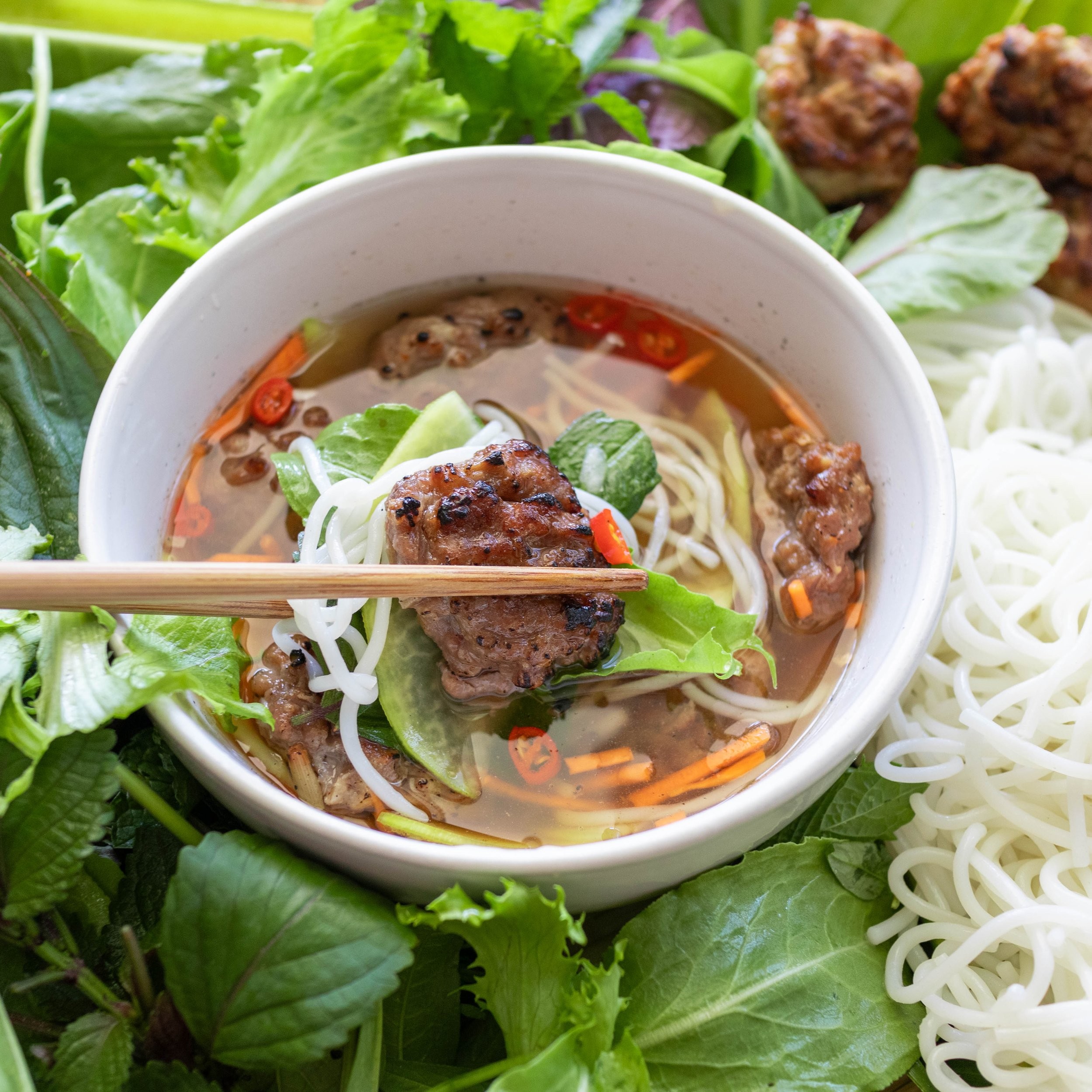 Finished Bún Chả Dish with Noodles and Herbs
Finished Bún Chả Dish with Noodles and Herbs
7. Essential Travel Tips for Enjoying Bún Chả in Hanoi
Planning a trip to Hanoi to savor authentic Bún Chả? Here are some essential travel tips to enhance your experience:
- Best Time to Visit: The ideal time to visit Hanoi is during the fall (September to November) or spring (March to May) when the weather is mild and pleasant, perfect for exploring the city and enjoying outdoor dining.
- Where to Find Authentic Bún Chả: Authentic Bún Chả can be found in numerous local eateries and street food stalls throughout Hanoi. Some of the most famous spots include Bún Chả Hương Liên (where President Obama dined with Anthony Bourdain), Bún Chả Đắc Kim, and Bún Chả Sinh Từ.
- Transportation: Navigating Hanoi is easiest by taxi, motorbike taxi (xe ôm), or ride-hailing apps like Grab. Consider renting a motorbike if you are comfortable driving in busy city traffic, but always wear a helmet. SIXT.VN offers convenient and reliable transportation services, including airport transfers and private car rentals, to help you explore Hanoi with ease.
- Accommodation: Hanoi offers a wide range of accommodation options, from budget-friendly hostels to luxurious hotels. Popular areas to stay include the Old Quarter, Hoan Kiem Lake area, and Ba Dinh district. SIXT.VN can assist you in finding the perfect hotel that fits your budget and preferences.
- Currency and Payment: The local currency is the Vietnamese Dong (VND). While credit cards are accepted in some establishments, it’s best to carry cash for street food stalls and smaller shops. ATMs are widely available throughout the city.
- Language: While English is spoken in tourist areas, learning a few basic Vietnamese phrases can enhance your interactions with locals. Phrases like “xin chào” (hello), “cảm ơn” (thank you), and “bao nhiêu?” (how much?) can be very useful.
- Safety: Hanoi is generally a safe city for tourists, but it’s important to be aware of your surroundings and take precautions against petty theft, especially in crowded areas. Keep your valuables secure and avoid displaying expensive jewelry or electronics.
- Health: Consult your doctor regarding necessary vaccinations and health precautions before traveling to Vietnam. It’s also advisable to drink bottled water and avoid ice from unknown sources to prevent stomach issues.
- Cultural Etiquette: When visiting temples and pagodas, dress respectfully by covering your shoulders and knees. It’s also polite to remove your shoes before entering someone’s home.
8. Unveiling the Health Benefits of Bún Chả
Bún Chả is not only delicious but also offers several health benefits, making it a balanced and nutritious meal:
- Rich in Nutrients: The combination of grilled pork, rice noodles, fresh herbs, and vegetables provides a variety of essential vitamins and minerals.
- Good Source of Protein: The grilled pork patties are an excellent source of high-quality protein, essential for muscle building and overall health.
- High in Fiber: The fresh vegetables and herbs contribute to a high fiber content, aiding in digestion and promoting gut health.
- Low in Fat: When prepared correctly, Bún Chả can be relatively low in fat, especially if lean pork is used and the patties are grilled rather than fried.
- Gluten-Free Option: As it is made with rice noodles, Bún Chả is a great gluten-free option for those with gluten sensitivities or celiac disease.
- Hydrating: The dipping sauce, often enjoyed as a broth, helps to keep you hydrated, especially in the hot and humid climate of Hanoi.
- Antioxidant Properties: The fresh herbs and vegetables are rich in antioxidants, which help to protect your body against cellular damage and reduce the risk of chronic diseases.
9. Addressing Common Concerns About Vietnamese Cuisine
Many tourists have concerns about trying Vietnamese cuisine, but these can be easily addressed:
- Hygiene Concerns: To avoid any potential issues, choose reputable restaurants and street food vendors with high ratings and positive reviews. Observe the cleanliness of the establishment and how the food is prepared.
- Spicy Food: While some Vietnamese dishes can be spicy, Bún Chả is generally mild. You can always ask for the chili peppers to be served on the side if you prefer to control the level of spiciness.
- Dietary Restrictions: Vietnamese cuisine offers many options for those with dietary restrictions. Bún Chả can be easily customized to accommodate gluten-free, vegetarian, and other dietary needs. Inform your server about your requirements, and they will be happy to assist you.
- Allergies: If you have any food allergies, be sure to inform your server before ordering. Common allergens in Vietnamese cuisine include peanuts, shellfish, and soy sauce. Most restaurants are familiar with these concerns and can provide information on ingredients and preparation methods.
- Unknown Ingredients: Don’t be afraid to ask about any ingredients you are unfamiliar with. Vietnamese chefs and vendors are often proud to share their knowledge of the cuisine and can provide valuable insights into the dishes they prepare.
10. Frequently Asked Questions About Eating Bún Chả
-
Can I make my own roasted rice powder if I can’t find it?
Yes, you can easily make your own roasted rice powder. Wash and rinse your favorite rice grains as if you are making steamed rice. Transfer the rice grains to a dry skillet and toast on medium-high heat, constantly tossing to brown the rice grains on all sides. Transfer the toasted rice grains to a mortar and pestle or food processor and grind them into a fine powder.
-
What if I don’t have rice grains to make roasted rice powder?
No problem, you can leave it out. It’s not too essential to the recipe and the Bún Chả will still taste very good without it.
-
Can I air fry the patties instead of grilling them?
Yes, you can air fry the patties. Preheat your air fryer to 350°F. Place the patties in the air fryer basket, leaving some space between them, and air fry for 5 minutes per side, or until lightly charred.
-
How can I make the patties/meatballs more bouncy and springy like in restaurants?
To make the patties more bouncy and springy, beat the pork mixture into a paste. This helps develop the myosin protein in the meat, giving the patties their elasticity. You can use a food processor to mix the pork mixture with a cup of ice cubes to prevent cooking during processing. Alternatively, you can beat the pork mixture by hand, throwing it against the bottom of the mixing bowl repeatedly, though this is more time-consuming.
-
What is the best way to store leftover Bún Chả?
Store leftover grilled pork patties in an airtight container in the refrigerator for up to 3 days. Store the rice noodles separately to prevent them from becoming soggy. Keep the dipping sauce in a separate container as well.
-
Can I freeze the pork patties for later use?
Yes, you can freeze the grilled pork patties. Allow them to cool completely, then place them in a freezer-safe bag or container. They can be stored in the freezer for up to 2 months. Thaw them in the refrigerator before reheating.
-
What are some common variations of Bún Chả?
While the classic Bún Chả includes grilled pork patties, some variations may include grilled pork belly (thịt ba chỉ nướng) or shrimp (tôm nướng). Some restaurants also offer vegetarian versions with tofu or mushrooms.
-
Is Bún Chả suitable for people with dietary restrictions?
Yes, Bún Chả can be easily adapted to suit various dietary restrictions. For gluten-free diets, ensure that the fish sauce and other ingredients do not contain gluten. For vegetarian diets, replace the pork patties with tofu or mushrooms.
-
What drinks pair well with Bún Chả?
Popular drinks to pair with Bún Chả include iced tea (trà đá), fresh coconut juice (nước dừa), and Vietnamese beer (bia hơi). These refreshing beverages complement the flavors of the dish perfectly.
-
How can I find the best Bún Chả in Hanoi?
Ask locals for their recommendations or check online reviews for top-rated Bún Chả spots. Exploring different eateries and trying their versions of the dish is a great way to discover your favorite Bún Chả in Hanoi.
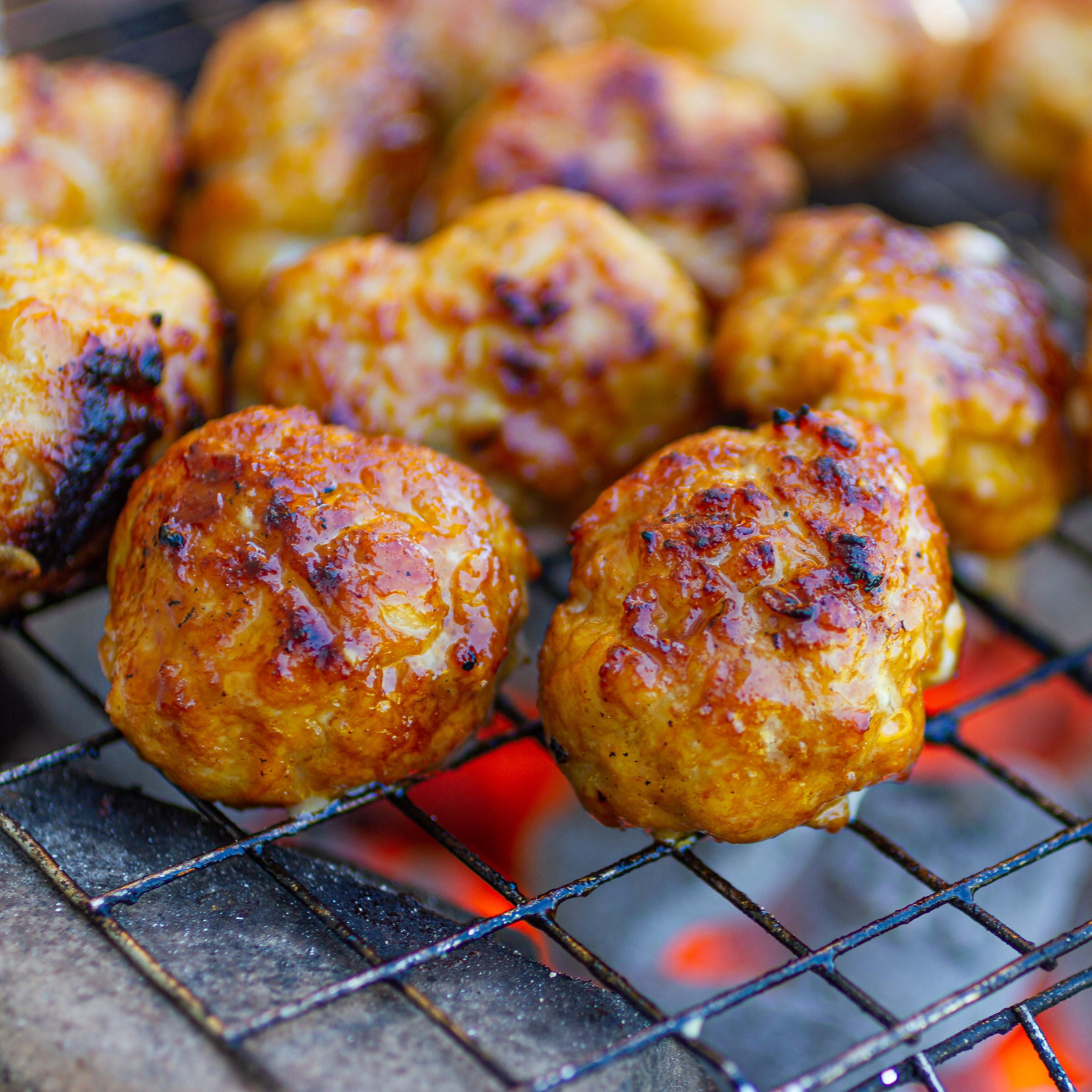 Pork Patties Grilling on Charcoal for Bún Chả
Pork Patties Grilling on Charcoal for Bún Chả
Ready to Discover Hanoi’s Culinary Delights?
Exploring the vibrant culinary scene of Hanoi is an adventure in itself. Understanding how to eat Bún Chả is just the beginning. At SIXT.VN, we are dedicated to providing you with seamless travel experiences, from airport transfers and hotel bookings to customized tour packages. Whether you are a solo traveler, a couple, a family, or a group of friends, we have the perfect services to meet your needs.
Don’t let the challenges of planning a trip to Vietnam hold you back. With SIXT.VN, you can enjoy a hassle-free journey, immersing yourself in the rich culture and delicious cuisine of Hanoi. Let us take care of the logistics while you focus on creating unforgettable memories.
Ready to start your culinary adventure in Hanoi? Contact us today to learn more about our comprehensive travel services and start planning your dream trip to Vietnam. Visit SIXT.VN for exclusive deals and personalized assistance.
Address: 260 Cau Giay, Hanoi, Vietnam
Hotline/Whatsapp: +84 986 244 358
Website: SIXT.VN



